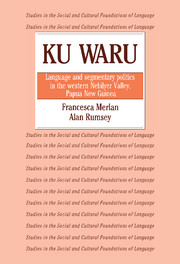Book contents
- Frontmatter
- Contents
- List of illustrations
- List of tables
- List of abbreviations
- Preface and acknowledgments
- 1 Introduction
- 2 The setting
- 3 Some aspects of Ku Waru segmentary sociality
- 4 Ceremonial exchange and marriage in the western Nebilyer Valley
- 5 Some linguistic structures of segmentary politics
- 6 Warfare compensation payment to Laulku: an analysis
- 7 Compensation at Palimung and the Kulka women's club
- 8 The events in perspective
- 9 Perspectives on ‘event’
- Appendix A Transcript of proceedings at Kailge on July 24, 1983
- Appendix B Grammatical sketch of Bo Ung, Ku Waru dialect
- Appendix C The conduct of warfare
- Appendix D Ku Waru metalinguistic expressions
- Chapter notes
- Glossary
- References
- Index
- Plate section
1 - Introduction
Published online by Cambridge University Press: 30 December 2009
- Frontmatter
- Contents
- List of illustrations
- List of tables
- List of abbreviations
- Preface and acknowledgments
- 1 Introduction
- 2 The setting
- 3 Some aspects of Ku Waru segmentary sociality
- 4 Ceremonial exchange and marriage in the western Nebilyer Valley
- 5 Some linguistic structures of segmentary politics
- 6 Warfare compensation payment to Laulku: an analysis
- 7 Compensation at Palimung and the Kulka women's club
- 8 The events in perspective
- 9 Perspectives on ‘event’
- Appendix A Transcript of proceedings at Kailge on July 24, 1983
- Appendix B Grammatical sketch of Bo Ung, Ku Waru dialect
- Appendix C The conduct of warfare
- Appendix D Ku Waru metalinguistic expressions
- Chapter notes
- Glossary
- References
- Index
- Plate section
Summary
Near the middle of the western Nebilyer Valley, in the Highlands of Papua New Guinea, there is a large expanse of grassland locally known as Sibeka Sweet Potato Garden. Though the ground there remains fertile even after thousands of years of cultivation, almost all of it has lain fallow since 1979, when it was used as a battleground between people living to the northeast and south of it. We heard about that fighting when we first visited the area in 1981 and settled at Kailge, immediately to the northwest (see Map 2). The Kailge people told us they themselves had not got into the fight. Fighting commenced at Sibeka again in 1982. This time our hosts at Kailge did join in, on the side of their eastern neighbors. The opposing side called in their allies from further south, and the Kailge people, in turn, called in their allies from over the Tambul Range to the west.
The way in which the 1982 battle ended was remarkable, to us and our hosts. On September 13, onto the battlefield marched the members of a local women's group, one of several that had grown up in this area since around the beginning of 1982. Dressed in identical T-shirts which bore the national insignia, and carrying the Papua New Guinea flag, the women marched into the no-man's-land between the opposing lines and exhorted the men on both sides to lay down their arms. They carried with them onions, cabbages, money, cigarettes and bottled soft drinks, and offered these to the combatants if they would desist. Both sides accepted the offer, the goods were divided equally between them, and they dispersed.
- Type
- Chapter
- Information
- Ku WaruLanguage and Segmentary Politics in the Western Nebilyer Valley, Papua New Guinea, pp. 1 - 19Publisher: Cambridge University PressPrint publication year: 1991

